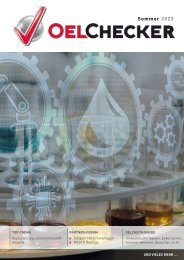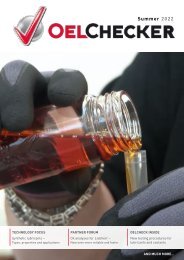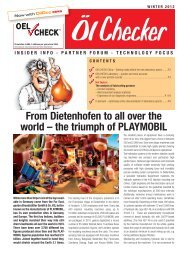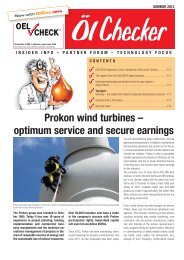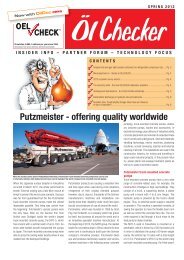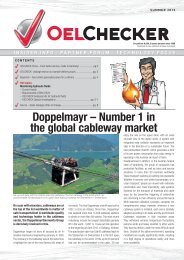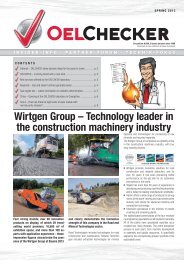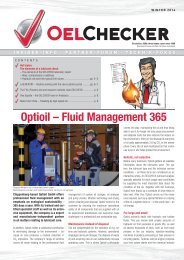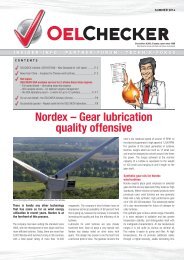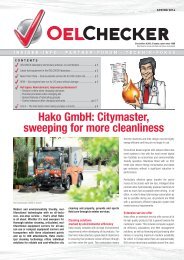OELCHECKER - Winter 2020
> Check-up – Breathe new life into your workplace > Typical limit values for the analysis of coolants > Technology focus: Gas chromatographs, the finest detection noses in the OELCHECK laboratory > > How gas chromatography works > > Gas chromatographs in use > Antioxidants – Elixirs of life for modern lubricants > > OELCHECK checks oxidation with the RULER test and IR spectroscopy > OELCHECK Inside: > > Communication and enjoyment in the new OELCHECK cafeteria > > OELCHECK customer survey 2020 – how to take part > Q&A: The shear viscosity of lubricating greases
> Check-up – Breathe new life into your workplace
> Typical limit values for the analysis of coolants
> Technology focus: Gas chromatographs, the finest detection noses in the OELCHECK laboratory
> > How gas chromatography works
> > Gas chromatographs in use
> Antioxidants – Elixirs of life for modern lubricants
> > OELCHECK checks oxidation with the RULER test and IR spectroscopy
> OELCHECK Inside:
> > Communication and enjoyment in the new OELCHECK cafeteria
> > OELCHECK customer survey 2020 – how to take part
> Q&A: The shear viscosity of lubricating greases
You also want an ePaper? Increase the reach of your titles
YUMPU automatically turns print PDFs into web optimized ePapers that Google loves.
<strong>Winter</strong> <strong>2020</strong><br />
INSIDER INFO PARTNER FORUM TECHNOLOGY FOCUS<br />
CONTENTS<br />
■ Check-up – Breathe new life into your workplace........................................................................................................ 2<br />
■ Typical limit values for the analysis of coolants............................................................................................................. 3<br />
■ Technology focus: Gas chromatographs, the finest detection noses in the OELCHECK laboratory<br />
– How gas chromatography works<br />
– Gas chromatographs in use...................................................................................................................................4-5<br />
■ Antioxidants – Elixirs of life for modern lubricants<br />
OELCHECK checks oxidation with the RULER test and IR spectroscopy......................................................................... 6<br />
■ OELCHECK Inside:<br />
– Communication and enjoyment in the new OELCHECK cafeteria<br />
– OELCHECK customer survey <strong>2020</strong> – how to take part............................................................................................. 7<br />
■ Q&A: The shear viscosity of lubricating greases ......................................................................................................... 8<br />
Coolants in stationary gas engines –<br />
Tectrol takes full advantage of analytics<br />
Tectrol has developed the Coolprotect range of<br />
coolants tailored to the requirements of the engines<br />
and the properties of Tectrol MethaFlexx gas<br />
engine oils. Ready-mix products were created in<br />
particular to permit simple and safe use.<br />
Regular sampling and checking of the gas engine oil, as shown in the photo, is not sufficient.<br />
Tectrol generally advises analysing the coolant after a maximum of 2,000 operating hours.<br />
The Tectrol brand stands for high-quality<br />
lubricants for almost all applications. Its<br />
core competencies include lubrication<br />
and cooling of stationary gas engines<br />
that generate energy in CHP plants. As<br />
a technological pioneer, Tectrol recognised<br />
at an early stage that high-performance<br />
gas engine oils can achieve<br />
successful results only in combination<br />
with oil analyses. Now it is also leading<br />
the way when it comes to monitoring the<br />
coolants of these gas engines. After all,<br />
it has become clear over the years that<br />
the cause of around 15% of all defects in<br />
gas engines can be found in their cooling<br />
systems. Tectrol and OELCHECK have<br />
therefore also maintained a long-standing<br />
cooperation in the field of coolant<br />
analysis.<br />
Tectrol MethaFlex gas engine oils offer the best<br />
protection for combined heat and power plant<br />
(CHP) gas engines even in long-term use. Over<br />
4,000 CHP engines powered by natural, bio or special<br />
gases use one of the more than ten Tectrol gas<br />
engine oil types. Together, the engines achieve over<br />
30 million operating hours per year!<br />
The cooling system<br />
as a source of danger<br />
Around 15 % of all faults in CHP systems have their<br />
starting point in the cooling system. However, the<br />
importance of the coolants was often underestimated<br />
or the handling of the fluids was not carried out<br />
correctly. Modern coolants are high-tech products<br />
on which the reliable performance of the cooling<br />
system and engine depends. Above all, they must<br />
continuously dissipate the heat from the engine,<br />
because this must be operated with only slight<br />
temperature fluctuations. A constant flow rate that<br />
is not affected by deposits or air inclusions is essential<br />
for this. The active ingredients added to<br />
the agents must reliably prevent corrosion, erosion,<br />
cavitation, foaming and any kind of deposits.<br />
Good compatibility with all installed components<br />
is a matter of course. The additives must protect<br />
the various metal alloys, elastomers and plastics<br />
installed in engines, cooling hoses, seals and in<br />
the expansion tank over the entire service life of<br />
the engine. If heat is not dissipated from thermally
Check-up<br />
A<br />
business<br />
trip! How nice would it be to go on a trip to a training<br />
event, seminar or symposium at the present time! Find out<br />
new things, exchange ideas, meet like-minded people and<br />
make interesting contacts again – we all need these stimuli and<br />
the contact with each other. However, further training and communication<br />
do not necessarily have to be paused when travel options<br />
are limited, and with your workplace even moved to within your own<br />
four walls.<br />
Breathe new life into your workplace! Take a digital trip to the<br />
world of lubrication and lubricant analysis! For example, our partners from the OilDoc Academy<br />
offer a whole range of exciting topics. You only need one hour for an online seminar. You can<br />
take part from anywhere. Instead of dry technical lectures, practically-oriented events full of information<br />
and examples await you. Many online training sessions are also available for you as recordings<br />
at any time.<br />
The seminars and certification courses lasting several days to convey more complex topics will<br />
continue to take place at the OilDoc Academy in 2021. Safety is ensured by a comprehensive<br />
protection and hygiene concept. Anyone who cannot be there in person still does not have to do<br />
without: at all face-to-face events, the camera is also on and you can take an interactive part in the<br />
seminar from your workplace.<br />
But no matter whether online excursion or a personal seminar visit – companies also benefit<br />
from the training events as well as the participants. After all, these depend more than ever<br />
on smoothly functioning systems and machines, as well as the commitment, knowledge and<br />
innovative ideas of their employees.<br />
Sincerely, Barbara Weismann<br />
loaded engine components, the gas engine oil is<br />
subjected to even higher demands. In most cases,<br />
its temperature load increases and the oil ages<br />
more quickly. Its viscosity and thus its lubrication<br />
performance decrease. Overall, the service life of<br />
the oil is shortened and the oil must be replaced<br />
sooner.<br />
Safe and fast with ready-mix<br />
Coolant concentrates are mixed with water before<br />
use. But tap water is often not suitable for this.<br />
Engine manufacturers specify accurate values for<br />
total hardness, electrical conductivity and the calcium<br />
or chloride content of the make-up water. Failure<br />
to comply with these specifications can lead to<br />
malfunctions in the cooling circuit. However, preparation<br />
of make-up water that meets specifications<br />
often poses major challenges for users.<br />
A pioneer in coolant analytics<br />
Tectrol began to very intensive work on coolant<br />
analysis as early as 2013. The challenges were<br />
not necessarily to determine individual values, but<br />
rather to define an analysis scope that was manageable<br />
for all users while at the same time allowing<br />
meaningful diagnosis. It also seemed difficult to<br />
find a laboratory for this type of water analysis at<br />
first. The solution was obvious: OELCHECK was<br />
already the proven partner for oil analyses and<br />
was already focused on coolant analysis back then.<br />
After intensive exchange with leading engine and<br />
coolant manufacturers, OELCHECK presented the<br />
groundbreaking analysis kits for coolants at the<br />
beginning of 2017.<br />
Tectrol: Analyses every<br />
2,000 operating hours<br />
OELCHECK universal kits for gas engines enable<br />
analysis of engine oils and coolants. Tectrol uses the<br />
universal kits in a targeted way. Customers order the<br />
kits conveniently from Tectrol and send the samples<br />
to OELCHECK for analysis. The laboratory reports<br />
are first sent with an initial diagnosis to the responsible<br />
employees in the Tectrol application engineering<br />
department. As they are familiar with the plants and<br />
the local operating conditions, their many years of<br />
experience are included in a concluding comment.<br />
This means that customers receive particularly individual<br />
and accurate diagnoses.<br />
As in the assessment of oil analyses, the interrelationships<br />
of the values determined for coolants are<br />
considered. The focus is on the remaining performance<br />
potential of the coolant and any indications<br />
of damage in the cooling system. However the limit<br />
values for the respective assessment criteria are a<br />
particular challenge for diagnosis. Many engine<br />
manufacturers have so far published no or<br />
very few limit values for used coolants. For<br />
this reason, OELCHECK and Tectrol have defined<br />
limit values based on their own experience and the<br />
existing broad database.<br />
Thanks to continuous trend monitoring, Tectrol was<br />
able to detect a number of system faults early on and<br />
recommend remedial measures to the user. However,<br />
the specified change intervals of coolants remain a<br />
critical topic. It is risky to simply replace them at regular<br />
intervals of one to three years without further consideration.<br />
Since operating conditions and coolants<br />
can change very quickly in some cases during use,<br />
well-known gas engine manufacturers already<br />
require short-term changes after 2,000 operating<br />
hours (max. 6 months) due to prematurely<br />
reached limit values.<br />
Tectrol generally advises coolant analyses after a maximum<br />
of 2,000 operating hours. Replacement is usually<br />
not recommended until the analysis values exceed<br />
or fall below limit values. With a preceding flushing<br />
process and the subsequent use of the ready-mix<br />
product from the Tectrol Coolprotect Mix series, this<br />
process can be completed without long interruptions<br />
in operation.<br />
Tectrol - a joint BayWa and Agravis brand<br />
Tectrol is a joint trademark of BayWa AG and Agravis<br />
Raiffeisen AG. It stands for high-quality lubricants for<br />
trade, industry and agriculture.<br />
BayWa is a globally active group with the core segments<br />
of agriculture, energy and construction as well as the<br />
development segment Innovation and Digitalisation. The<br />
Renewable Energies business unit has developed into an<br />
important mainstay since 2009. With 19,000 employees<br />
in more than 40 countries, the company generated sales<br />
of over 17 billion euros in 2019.<br />
AGRAVIS Raiffeisen AG is a modern agricultural trade<br />
company in the agricultural products, animal nutrition,<br />
crop cultivation and agricultural technology segments. It<br />
also operates in the areas of energy and Raiffeisen markets,<br />
including the building material trade and project<br />
construction. With around 6,500 employees, the AGRAVIS<br />
Group generates 6.5 billion euros in sales revenue.<br />
Coolant analytics – Typical limit values<br />
As with the evaluation of lubricant analyses, OELCHECK tribologists also always consider the interrelationships of the values defined for coolants. They also take<br />
into account individual conditions of use and the results of previous trend analyses.<br />
The limit values or tolerance ranges published here are for general guidance only. They are based on the specifications of well-known engine manufacturers and on<br />
the data of all coolant samples that OELCHECK has examined since 2017.<br />
in Typical range Warning value Explanations<br />
Tectrol has the perfect solution for this: ready-mix<br />
coolant from the Tectrol Coolprotect-Mix series! The<br />
Formate mg/l
OELCHECK TECHNOLOGY FOCUS<br />
Gas chromatographs –<br />
The finest detection noses in the OELCHECK laboratory<br />
Is a used engine oil contaminated with fuel? Has an engine oil<br />
been too heavily contaminated with biodiesel or vegetable oil?<br />
Has the wrong fuel been refuelled? Is there coolant in the oil<br />
sample? Does the DGA (dissolved gas analysis) of a transformer<br />
oil show a gas composition that indicates a likely fault in<br />
the transformer in the near future?<br />
OELCHECK tribologists are confronted with such questions on<br />
a daily basis. Gas chromatography (GC) provides exact information<br />
to answer these questions as it can be used to analyse<br />
substance mixtures both quantitatively and qualitatively.<br />
The prerequisite for an analysis is that the mostly liquid samples<br />
become gaseous without decomposition when heated or<br />
are already gaseous.<br />
Four gas chromatographs are installed in the OELCHECK laboratory for analysis<br />
of up to 2,000 samples that are tested daily. Although set up for different<br />
purposes, they work according to a uniform principle. The sample to be examined<br />
is fed to the gas chromatograph via an injector. It then vaporises the<br />
sample. The now gaseous components are injected into a capillary column<br />
mounted in a thermally controllable oven. Gases pass through a long, thin glass<br />
tube with an inner diameter of less than 1 mm but with a length of up to 30<br />
m. This is coated internally with a thin film, the stationary phase. A carrier gas<br />
such as hydrogen or argon, the mobile phase, continuously flows through this<br />
separation column. The gaseous components of the sample supplied from the<br />
injector remain at the stationary phase of the column for different lengths of<br />
time depending on their structure and the temperature in the oven chamber. As<br />
the individual components leave the column, a detector identifies them. They<br />
are recorded in a chromatogram and can be assigned to specific initial materials<br />
according to their boiling temperature. The later a component is detected<br />
at the column outlet, the higher its boiling point. The area under a peak in the<br />
chromatogram is proportional to the amount of the component in the mixture.<br />
Gas chromatographs in use<br />
Fuel in engine oil –<br />
Too much is unhealthy<br />
In the OELCHECK laboratory, the fuel content of all<br />
used engine oils from diesel, petrol and biodiesel engines,<br />
with the exception of oils from gas engines, is<br />
tested with the gas chromatograph. As the components<br />
of fuels generally have a lower boiling point than<br />
those of engine oils, they can be separated from<br />
each other and quantified using gas chromatography.<br />
The laboratory report specifies the percentages<br />
of the respective fuels in % (m/m).<br />
Unburned fuel can always get into the engine oil<br />
during fuel combustion in the engine. However, if it<br />
contains too much fuel, its viscosity decreases and<br />
a wear-protecting lubricating film can no longer build<br />
up reliably. Increased fuel input can be due to a wide<br />
variety of causes:<br />
• Frequent cold starts with formation of con densation<br />
• Extreme stop-and-go operation<br />
Separating column of a gas chromatograph<br />
Carrier gas<br />
Sample syringe<br />
• Condensation of blow-by gases due to incorrectly<br />
set carburettor or poor timing<br />
• Incomplete combustion due to insufficient compression<br />
as a result of worn cylinders or piston<br />
rings<br />
• Incorrect fuel/air mixture due to blocked air filter,<br />
damaged inlet or outlet valves<br />
• Incorrectly set ignition time, defective injection<br />
nozzles, burnt spark plugs<br />
• When using biodiesel (RME, FAME), it must be<br />
noted that this type of fuel has a higher boiling<br />
temperature than fossil diesel and vaporises<br />
less well at operating temperature.<br />
OELCHECK tribologists have defined limit and warning<br />
values for the permissible fuel content for different<br />
engine and fuel types.<br />
Injector<br />
Detector<br />
Separation column<br />
Principle of gas chromatography (simplified scheme)<br />
Components<br />
adsorb / desorb<br />
Rule of thumb: The engine oil of a petrol engine<br />
should never contain more than 1-2 % fuel. For<br />
diesel engines, the limit value is 5-7 %. In operation<br />
with pure biodiesel (B100), a share of more<br />
than 6 % is usually considered critical.<br />
Ethylene glycol in engine/<br />
transmission oils –<br />
The indicator for coolant contamination<br />
The headspace gas chromatograph in the<br />
OELCHECK laboratory is used for this analysis. This<br />
detects even very low levels of ethylene glycol, the<br />
clear indicator of coolant contamination, with high<br />
precision.<br />
The analysis must be commissioned as an individual<br />
test. In the laboratory report, the GC glycol content in<br />
mg/kg is indicated under the heading “Contamination”.<br />
Headspace gas chromatography is a special variant<br />
of the GC procedure to separate volatile components<br />
of a substance mixture from non-volatile or hardly<br />
volatile constituents. First, a reagent is added to the<br />
oil sample which derivatises the ethylene glycol contained<br />
in the sample. The oil sample is then heated<br />
to 120 °C in a tightly sealed glass bottle. The volatile<br />
components – including the derivatised ethylene glycol<br />
– evaporate. This vapour is collected and a sample<br />
separated from it. All the components contained<br />
in the vapour are then separated according to their<br />
boiling points in the gas chromatograph. The ethylene<br />
glycol is detected precisely. This method provides<br />
even more accurate data than the FT infrared spectroscopy<br />
routinely performed for all analysis kits.<br />
Particularly in the case of increased water content,<br />
detection of glycol in the engine or transmission oil<br />
provides a clear indication that coolant has entered<br />
into the oil circuit. If glycol is detected in the oil, it is<br />
very important to check how the coolant entered the<br />
lubricating oil. The most common cause in internal<br />
combustion engines is a defective seal. With a transmission<br />
oil cooler, the pipes, which usually contain<br />
copper, can be corroded in such a way that leaks<br />
have formed.<br />
“Simulated distillation” –<br />
Fuels in the spotlight<br />
Commercially available fuels vaporise at different<br />
temperatures. The vaporisation process is simulated<br />
as distillation with the gas chromatograph. The distillation<br />
process is recorded in a boiling profile. The data<br />
obtained is compared with the standardised characteristic<br />
values of the individual fuel types.<br />
This shows whether fossil diesel or biodiesel meet<br />
the requirements of the standard. Incorrect refuelling<br />
or impurities, such as petrol with diesel, diesel with<br />
biodiesel, can also be clearly detected. Even a mixture<br />
of conventional fuels with vegetable oil is visible.<br />
However, such contamination is usually detected by<br />
other test methods, such as FT-IR spectroscopy or<br />
viscosity change.<br />
For diesel fuel, the cetane index, a measure of<br />
ignitability in accordance with EN 590, can also be<br />
determined with the help of the “simulated distillation”<br />
and the density. The cetane index provides<br />
information on the speed of self-ignition of the diesel<br />
fuel after injection. The higher the cetane index, the<br />
better the diesel grade because the time between<br />
injection and combustion decreases and the ignitability<br />
increases.<br />
Fossil diesel fuel, which must contain 7 % biodiesel<br />
according to the standard, must have a cetane<br />
index of at least 46. Diesel fuels with a higher biodiesel<br />
content of 10, 30 or even 100 % have a<br />
lower cetane index. If a borderline value or even<br />
lower value is determined in the analysis performed<br />
in the OELCHECK laboratory, this indicates a diesel<br />
whose biodiesel content is higher than in EN 590<br />
and whose use can cause a reduction in engine<br />
performance or ignition problems.<br />
The evaporation loss –<br />
Specialist for special cases<br />
Measurement of evaporation loss is an extension<br />
of the “simulated distillation”. OELCHECK performs<br />
determination of the evaporation loss with the gas<br />
chromatograph as an individual analysis that must<br />
be commissioned separately. It is used, among<br />
other things, for the assessment of mostly synthetic<br />
base oils selected for the formulation of new<br />
engine or compressor oils. Completely formulated<br />
high-temperature lubricants, such as those used for<br />
lubrication of chains in furnace systems, glass and<br />
chipboard production as well as in film stretching<br />
lines, can thus be assessed before practical use.<br />
During the analysis, an oil sample is heated in the<br />
injector of a gas chromatograph and its components<br />
are differentiated in a separating column depending<br />
on their rising boiling temperature. The diagram of<br />
the boiling process is divided into equidistant intervals<br />
of 1 % of the total area. In each of these<br />
intervals, the measured mass fraction of the sample<br />
is multiplied by a specific evaporation loss factor.<br />
The higher the boiling temperature, the smaller this<br />
factor. It is necessary to include the loss factor in<br />
calculation as this measurement is not a real distillation,<br />
but a simulated one. The calculation determines<br />
a partial evaporation loss for each interval.<br />
These partial evaporation losses then result in the<br />
total evaporation loss.<br />
As a result, the evaporation loss of a<br />
sample at a temperature of 250 °C can<br />
be determined. The most important prerequisite<br />
for the measurement using this<br />
procedure is that the sample must be fully<br />
vaporisable.<br />
Gas-in-oil analysis –<br />
Safety for transformers<br />
Insulating oils are intended to prevent voltage flashovers<br />
in transformers and extinguish any arcs<br />
during switching. They insulate and cool live parts,<br />
are characterised by low-temperature and oxidation<br />
stability, and harmonise with winding and insulating<br />
materials. The oils often remain in use for decades<br />
and must be monitored by means of trend analyses.<br />
OELCHECK offers five analysis kits especially for<br />
transformer oils which permit determination of the<br />
gases dissolved in the oil. Besides water determination,<br />
this gas-in-oil analysis is the most important<br />
analysis for monitoring transformers, as it makes a<br />
decisive contribution to operational safety. A special<br />
headspace gas chromatograph is used for the<br />
analysis. The laboratory report lists values for the<br />
respective gases determined in ppm and their total.<br />
Gas-in-oil analysis uses the insulating oil’s ability<br />
to dissolve air from the atmosphere as well as cracked<br />
gases. These are produced not only due to the<br />
natural ageing of oil and insulation materials, but<br />
above all when thermal or electrical defects occur<br />
in transformers. The extent of a defect and remedial<br />
measures can be concluded from the quantity of<br />
dissolved gases in the respective oil and their increase<br />
over time (trend analysis).<br />
To obtain correct measurement results, the oil sample<br />
must not come into contact with the ambient air. OEL-<br />
CHECK therefore equips every all-inclusive analysis<br />
kit for transformer oils not only with a hermetically<br />
sealable sample bottle, but also with a gas-tight<br />
20 ml glass syringe. Only this must be used to take<br />
a sample.<br />
In the laboratory, the type and intensity of the gases<br />
contained in the oil are determined with a gas<br />
chromatograph. Depending on the intensity of the<br />
individual gases, it is then possible to differentiate<br />
between different fault types. Conclusions regarding<br />
the consequences for the transformer oil or paper<br />
insulation can be drawn from the corresponding<br />
fault types. These values and their diagnosis are<br />
noted in the laboratory report in compliance with<br />
evaluation procedures defined in the VDE standard.<br />
Gas chromatograph at OELCHECK<br />
OELCHECK all-inclusive analysis kit<br />
4 for insulating and transformer oils<br />
5
Antioxidants –<br />
Elixirs of life for modern lubricants<br />
OELCHECK checks oxidation with the RULER test and IR spectroscopy<br />
Das Öl in der Maschine<br />
For OELCHECK customers,<br />
the basic procedure<br />
remains unchanged.<br />
However, the parameters are<br />
determined even more precisely<br />
by different methods, providing<br />
greater confidence in the interpretation<br />
of laboratory results.<br />
100 %<br />
catalyt. Metals<br />
Incubation Acceleration Saturation<br />
Antioxidants<br />
Interfacial<br />
tension<br />
Time<br />
Typical progression of oil oxidation over time<br />
Acidification<br />
Peroxides<br />
free radicals<br />
The ageing process to which all lubricants are subjected<br />
during their use is essentially dominated by<br />
the oxidation of the base oil. The speed of this oxidation<br />
process is mainly influenced by temperature.<br />
For mineral oils without additives, the rule of thumb<br />
(Arrhenius rule) applies that oxidation doubles from<br />
an operating temperature of approx. 60 °C when<br />
the temperature increases by 10 °C in each case.<br />
In modern lubricants, “antioxidants” delay this acceleration<br />
process. However, the more these active<br />
ingredients are consumed, the less the oil is able<br />
to effectively brake the oxidation process.<br />
The greater the extent to which the antioxidants<br />
have degraded, the higher the likelihood that sticky<br />
oxidation products, often referred to as varnish,<br />
will develop. The change in antioxidants is<br />
used as an early warning system for a risk due<br />
to formation of deposits. OELCHECK has been<br />
using the RULER test, combined with infrared<br />
spectroscopy, for over 20 years.<br />
More efficient machines,<br />
better lubricants<br />
Increasingly faster and more heavily loaded machines<br />
as well as longer oil life often lead to a<br />
higher temperature load on the lubricants. This in<br />
turn accelerates oil oxidation. The minimum requirements<br />
for many industrial lubricants are defined<br />
in DIN or ISO standards, which are regularly adapted.<br />
Lubricant manufacturers meet the increasing<br />
requirements by using saturated base oils (Group II<br />
or III), which are additionally improved with a higher<br />
proportion of newly formulated antioxidants.<br />
Oil sludge<br />
This is particularly evident<br />
for circulating oils used for<br />
turbine lubrication. Until a<br />
few years ago, conventional<br />
turbine oils were based<br />
on API Group I base oils.<br />
They were predominantly<br />
mixed with phenolic antioxidants,<br />
combined with<br />
some amines, sulphides or<br />
phosphates. Modern turbine<br />
oils are manufactured<br />
from mineral API Group II<br />
(hydrotreated) or Group III<br />
(hydrocracked) base oils<br />
or even synthetic PAO oils<br />
(Group IV). Aminic antioxidants are mainly used as<br />
additives for these oils. Phenolic active ingredients<br />
are now only contained in low concentrations.<br />
Both turbine oils have two characteristic peaks<br />
in the RULER diagram (see figure below). Each<br />
represents a type of antioxidant. In the left diagram,<br />
a relatively high content of phenolic antioxidants<br />
is visible with the second peak. The right diagram<br />
is typical for a turbine oil with a Group II base oil.<br />
While the signal for the phenolic antioxidants is<br />
only weak, the signal for the aminic antioxidants<br />
dominates. The RULER test provides very reliable<br />
statements about the degradation of aminic antioxidants<br />
in modern turbine oils. However, statements<br />
about the phenolic antioxidants are compromised<br />
due to their very low concentration.<br />
Intensive investigations have shown that changes<br />
in phenolic antioxidants, especially at low concentrations,<br />
can be reliably determined with FT-IR<br />
spectroscopy.<br />
FT-IR diagram of turbine oil with aminic and phenolic<br />
antioxidants<br />
The aminic antioxidants can also be detected<br />
by FT-IR. However, the “adjacent” wave number<br />
ranges are subject to interference with other compounds,<br />
especially for synthetic base oils. The<br />
repeatability of the quantitative detection of the<br />
aminic antioxidants can therefore be severely impaired.<br />
In this case, determination by means of the<br />
RULER test provides significantly more stable and<br />
meaningful results.<br />
Antioxidant testing:<br />
New concept<br />
Modern lubricants are usually produced on the<br />
basis of saturated base oils. For these oils developed<br />
for long-term use, it is very important to know<br />
the content of residual effective antioxidants.<br />
OELCHECK tribologists have therefore decided<br />
to adapt the concept of the parameters that are<br />
important for diagnosis. In future, the phenolic<br />
antioxidants will be determined in the OELCHECK<br />
laboratory using FT-IR, while aminic antioxidants<br />
will be determined using the RULER test. As before,<br />
both values are reported and assessed in % of residual<br />
effective antioxidants compared to fresh oil.<br />
RULER diagrams of turbine oils<br />
Left, old formulation: high phenol content. Right, current formulation: low phenol content<br />
OELCHECK INSIDE<br />
Eating together creates<br />
communication and community.<br />
With a view to promoting the well-being of employees,<br />
OELCHECK has integrated a cafeteria in the<br />
new company building – not only for pure intake<br />
of food, to be performed quickly between two appointments,<br />
but also to allow all employees to take<br />
an enjoyable break.<br />
Since mid-September, employees have met here<br />
to eat together, share ideas – to network. And then<br />
to drink a cappuccino or coffee together in the<br />
lounge area. This relaxed atmosphere encourages<br />
creative thinking. Of course, strict attention is paid<br />
at the moment to compliance with the coronavirus<br />
protection measures.<br />
In cooperation with the Bad Aibling specialist catering<br />
company, an innovative concept for canteen<br />
catering is being implemented in the new cafeteria.<br />
The vision is to enhance daily work at the company<br />
with local ingredients, uncompromising freshness<br />
and skilfully prepared meals. OELCHECK employees<br />
thus enjoy a healthy and individual lunch<br />
every day – freshly prepared by Daniel Baranowski,<br />
the head chef.<br />
The design of the new cafeteria is modern and<br />
inviting. A place has been created here where<br />
employees can feel comfortable. At OELCHECK,<br />
community spirit is shown in daily interaction and<br />
now also at daily lunch – just as it should be in<br />
a family business. Good food. Nice surroundings.<br />
More productive employees!<br />
For business partners, customers and visitors, there<br />
is also a meeting room in the new company building<br />
with a separate connected hospitality room.<br />
OELCHECK needs your feedback<br />
Since 1991, we have conducted intensive testing of your lubricants and consumables and are doing our best on your behalf.<br />
But are you really satisfied with our services? What could we do even better?<br />
Please take 10 minutes to complete<br />
our online customer survey by January 31, 2021!<br />
Only with your support can we continuously expand<br />
and optimise our services. And as a customer of<br />
OELCHECK, you will benefit from this! Your personal<br />
answers will of course be treated confidentially.<br />
We will publish a summary of all results and our<br />
reactions to your suggestions in spring 2021 in<br />
the next issue of <strong>OELCHECKER</strong>, our customer<br />
magazine.<br />
On behalf of the entire OELCHECK team, we<br />
thank you for your active support!<br />
By the way: As a thank you, at the end of the<br />
survey you will receive a voucher code for a 25%<br />
discount on an online training or seminar from our<br />
OilDoc partners. So it’s worth taking part!<br />
6<br />
7
In the last laboratory report for the analysis<br />
of our used lubricating grease, we noticed<br />
data for shear viscosity and relative viscosity<br />
loss for the first time. What do these<br />
analysis values mean? Are they intended<br />
to replace the unworked penetration<br />
value? The unworked penetration or its<br />
change does not appear in the laboratory<br />
report, although it is<br />
included in the list of<br />
analyses of the allinclusive<br />
analysis<br />
kit 5 for greases.<br />
OELCHECK:<br />
Unworked penetration and consistency<br />
Every grease changes during use. It becomes<br />
softer or harder, depending on load and thickener.<br />
However, a solid or softened used grease can<br />
be dangerous for the lubricated element. This is<br />
why we determine penetration as part of the allinclusive<br />
analysis kit 5. It provides information<br />
about this change and also enables the grease<br />
to be assigned to the NLGI consistency class. A<br />
change compared to fresh grease informs you,<br />
among other things, whether the grease can still<br />
be distributed well in a bearing or whether it has<br />
softened to such an extent that it bleeds out. To<br />
determine the unworked penetration, 3 ml of used<br />
grease is poured into a pot. A special cone is<br />
placed on its surface. Its penetration depth into<br />
the grease is measured after 5 seconds in 0.1<br />
mm and specified as penetration.<br />
Shear viscosity – a practical test<br />
An OELCHECK grease sampling hose holds 9 ml, a<br />
sufficient amount of grease for all tests. Especially<br />
in bearings with low grease filling, the amount<br />
required for penetration measurement is sometimes<br />
not available because the grease has already been<br />
consumed for the other analyses. In these cases, a<br />
rheometer (rotational viscometer) is used. It measures<br />
the change in “dynamic viscosity” or shear viscosity<br />
based on 1.5 ml of grease. This allows information<br />
about the change in penetration to be obtained<br />
indirectly.<br />
Q&A<br />
<strong>Winter</strong> <strong>2020</strong><br />
During the analysis, a grease blob is applied to a<br />
lower plate with a diameter of approx. 3 cm. An<br />
upper plate of equal size is lowered to 1 mm from<br />
the lower plate and then rotated. This simulates the<br />
behaviour of the grease in the lubrication gap in a<br />
practically-oriented manner.<br />
The resistance between the upper and lower<br />
plates can be measured as dynamic viscosity<br />
in Pa·s (Pascal seconds) and specified as shear<br />
viscosity for lubricating greases. The velocity gradient<br />
between the plates is given as the shear rate<br />
in 1/s. The percentage change is calculated as<br />
a “relative viscosity change” of the shear viscosity<br />
with known fresh grease. The changes allow<br />
conclusions to be drawn as to how strongly the<br />
grease can still resist the effect of shear forces in<br />
comparison with fresh grease.<br />
On the basis of the absolute value of the shear<br />
viscosity as well as the percentage viscosity loss,<br />
the tribologist assessing your grease sample at<br />
OELCHECK can derive whether the thickener can<br />
still transfer sufficient lubricating oil to the friction<br />
point under load. Relubrication intervals can also<br />
be defined by assessing whether the grease has<br />
already become so “thin” due to shearing of the<br />
grease structure that it runs out of the bearing and<br />
should therefore be refilled more frequently.<br />
However, not only the fresh grease values are used<br />
to evaluate the sample. A comparison with the results<br />
of previous trend analyses is also carried out,<br />
taking into account the individual characteristics<br />
of the grease and any relubrication quantities.<br />
An increase in apparent viscosity can mean that<br />
the grease no longer supplies enough oil to the lubrication<br />
point. There are several possible causes<br />
for this:<br />
• there was no relubrication at all or relubrication<br />
was not sufficient<br />
• the grease has oxidised, among other things<br />
due to a high temperature load<br />
• the thickener structure has sheared and there<br />
is not enough oil in the rheometer because the<br />
grease has already bled out.<br />
As a general rule of thumb: from a relative viscosity<br />
loss of 7.5 %, relubrication must be carried<br />
out soon; it must be performed immediately as<br />
from 10 %.<br />
PUBLISHER<br />
<strong>OELCHECKER</strong> – a magazine of OELCHECK GmbH<br />
Kerschelweg 28 · 83098 Brannenburg · Germany<br />
info@oelcheck.de · www.oelcheck.de<br />
All rights reserved. Reproduction is only permitted after<br />
receiving our approval.<br />
Concept and text:<br />
OELCHECK GmbH · Astrid Hackländer<br />
Layout and design:<br />
Agentur Segel Setzen, Petra Bots, www.segel-setzen.com<br />
Photos: Tectrol · Fluitec · OELCHECK<br />
Grease selection and<br />
relubrication intervals<br />
Shear viscosity and relative viscosity loss depend<br />
on the properties of the grease. It consists of approximately<br />
90 % base oil and additives and approximately<br />
10 % thickener. The latter holds the base<br />
oil and additives with its sponge-like structure and<br />
slowly releases them into the lubrication point during<br />
use. Modern complex greases (with complex<br />
soap thickener based on lithium, calcium, aluminium)<br />
and gel greases (with non-soap thickener)<br />
behave differently to conventional multi-purpose<br />
greases with their simple soap structure. The modern<br />
grease types have a particularly fine-pored<br />
thickener structure, which makes the oil output<br />
finer and more even. The viscosity change of these<br />
greases is around 1 % when fresh. In contrast, the<br />
value is around 4 % for conventional multi-purpose<br />
greases with a simple soap structure.<br />
Each grease behaves individually in use. If a new<br />
product needs to be selected for a specific application<br />
and/or its relubrication intervals need to<br />
be optimised, the shear viscosity and relative viscosity<br />
loss should therefore be determined under<br />
practically-based conditions with the aid of trend<br />
analyses in the OELCHECK laboratory, especially in<br />
the case of complex and gel greases. We compare<br />
the used grease values with the fresh grease values.<br />
The specifications from data sheets as well as<br />
the technical data determined by us are contained<br />
in the large OELCHECK fresh grease database for<br />
almost all available lubricating greases. Only in exceptional<br />
cases do we also need a sample of the<br />
fresh grease from you to assess the shear viscosity.<br />
Top tip: More information on possible analyses for<br />
lubricating greases can be found in <strong>OELCHECKER</strong><br />
<strong>Winter</strong> 2012 and under “Downloads” on our website<br />
www.oelcheck.de. There are also instructions<br />
on how to correctly take grease samples and many<br />
practical tips!<br />
8<br />
OELCHECK will be glad to answer any questions you may have about tribology or lubricant analyses.<br />
Contact us by email (info@oelcheck.de) or fax +49 8034 9047-47.




